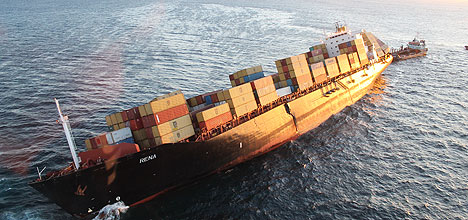Two serious incidents involving professional divers working on the Rena have given the Resolve Salvage team a scary shake-up.
The two men – a 25-year-old New Zealander and 31-year-old American – were both taken to Tauranga Hospital for treatment following the separate incidents on October 19 and 29.
The container ship Rena struck Astrolabe Reef on October 5, 2011.
They are part of a team of divers working at deep sea levels to prepare for the removal of the wreck's accommodation block next month.
Resolve project manager in Tauranga Ajay Prasad says the incidents have affected an otherwise high morale among the Resolve Salvage team.
'The team is thankful neither diver suffered serious injury, after such incidents it takes a bit to refocus on the task ahead.
'Managing risk is a big part of our work and on this job there's a lot to take into account because of the depths, confined work spaces and hydro dynamic environment.”
Rena recovery spokesperson Hugo Shanahan says on October 19, the Kiwi diver reported experiencing breathing problems while at approximately 110 feet, or 34 metres.
Having alerted his dive supervisor to the problem, he was instructed to flush his helmet and return to the surface. Back on board the barge, he was placed in a hyperbaric chamber, he says.
During the second incident on October 29, Hugo says the American diver's umbilical snagged in two separate locations while he was ascending from 151feet, or 46 metres. He had to descend again to clear both obstacles.
The man reached the barge and was recompressing when he began to show signs of oxygen toxicity while in the hyperbaric chamber, says Hugo.
Following treatment at Tauranga Hospital last month, both men have since be cleared to return to work.
An industry spokesman says Rena divers are on surface supply. Their breathing gas is pumped into a fibreglass dive helmet over an umbilical line that also carries communications.
The diver breaths through an oral/nasal that feeds air through a demand valve regulator on the front of the hat. It does not actually go into the mouth like a scuba regulator. Becasue of the oral/nasal the diver does not have anything in his mouth, so he can talk.
To operate it safely and avoid Co2 build up in the helmet the hood lining has to be a tight fit to push the diver's face right into the mask so there are no gaps where Co2 can build up – something that can be over looked in a rush to take over gear that has recently been used by another, says the spokesman.
Divers are working under literal pressure at 34 metres. They are also under pressure to complete tasks in what can be narrow weather windows afforded by the weather on Astrolabe Reef.
They are using a commercial technique called surD-02 where the diver overruns the normal bottom time, he says.
When they surface, the divers do one, two-minute decompression stop at 12 metres, then they are out of the water and into the chamber where they are recompressed back to 12 metres depth while breathing oxygen.
It is a technique that reduces by hours the amount of time that has to be spent in decompression.
The divers are part of a specialist team undertaking a major operation at depths of up to 50 metres to prepare for the removal of the wreck's accommodation block next month.
The house is at the deep end of the sunken aft section, which lies wedged at a 55 degree angle to starboard and down to a depth of 65 metres on the Eastern side of the Astrolabe Reef.
Preparing the house for removal involves burning rigging holes and clearing internal pathways to enable approximately 2000metres of large industrial three-inch wire chains that will be used to saw the house into two, 350-tonne blocks.
Due to the extensive burning and cutting operation, involving divers working at depths down as far as 160 feet, 50 meters, in places, safety vents have had to be cut into the house's structure to allow pockets of hydrogen gas that could accumulate to escape.
Other preparations in recent months also involved cutting down and removing major protruding features from the house, such as the wreck's funnel, to reduce drag and weight once the major lifting operation gets underway.
Once cut, the two sections weighing approximately 350-tonnes each will be lifted onto the RMG1000, a second barge to be transported to port where they will be dismantled for scrap and, where possible, recycling.



1 comment
Leave it there
Posted on 07-11-2013 07:27 | By freedomkiwis
Do lives really need to be put at risk. Can the Rena not just stay there now and become a reef?? Awful lot of money being spent on this one, to what end?
Leave a Comment
You must be logged in to make a comment.